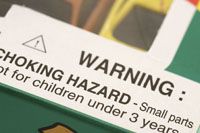Do You Need a Consumer Product Safety Whistleblower Lawyer?

- Have you warned your company that it's making or distributing an unsafe product?
- Have you uncovered violations of CPSC product safety rules?
- Is your employer threatening your career so that you'll stay quiet?
If you're an employee facing retaliation after you filed a product safety report, the law is on your side.
The Consumer Product Safety Improvement Act of 2008 (CPSIA) is a federal law that forbids retaliation against employees who report a violation of standards set by the Consumer Product Safety Commission (CPSC). Under the law's CPSC whistleblower-protection provision, employers may be required to pay damages for any illegal harm suffered by a good-faith whistleblower. If you were fired after making a product safety report, the CPSIA may help you to get your job back.
The whistleblower attorneys at The Employment Law Group® law firm are experienced in representing employees in the forums where claims of CPSIA retaliation are litigated, both before the U.S. Department of Labor (DOL)—which enforces the law—and in federal court. We are based in Washington, D.C., but we take cases nationwide.
More about our law firm
If you have suffered illegal workplace discrimination under the CPSIA, you may be entitled to reinstatement in your job; back pay for lost wages; front pay for future lost wages; litigation costs and attorney fees; and other special damages.
As with all legal claims, deadlines are crucial. If you have been retaliated against, you must file a complaint with the DOL within 180 days of becoming aware of the retaliatory adverse action.
Frequently Asked Questions
What activities are covered by CPSC whistleblower protection?
The CPSIA prohibits manufacturers, private labelers, distributors, and retailers from retaliating against an employee because the employee provided information about a reasonably perceived violation of the CPSIA or any other act enforced by the CPSC. Under the CPSIA, employers may not discharge or otherwise discriminate against employees for: (1) providing information about a violation of the CPSIA or any law enforced by the CPSC to the employer, the Federal Government, or the State Attorney general; (2) testifying or assisting in a proceeding concerning a violation of the CPSIA or any law enforced by the CPSC; or (3) refusing to participate in an activity, policy, practice, or assigned task that they reasonably believe violates the CPSIA or any law enforced by the CPSC. Specific examples of protected conduct include:
- Reporting violations of the standard for the flammability of children’s sleepwear;
- Disclosing information about the use of consumer patching compounds containing free-form asbestos;
- Reporting an employer’s violation of a safety standard for creating architectural glazing materials;
- Reporting choking incidents involving marbles, small balls, latex balloons, and other small parts;
- Reporting the export of banned or misbranded products;
- Disclosing information about an employer’s import or distribution of new all-terrain vehicles in violation of the CPSIA; and
- Providing information about an employer who manufactures a toy that contains an unsafe amount of lead.
How can a whistleblower prove illegal retaliation?
The CPSIA’s employee protections are similar to those of the Sarbanes-Oxley Act of 2002 (“SOX”). Plaintiffs must prove (1) that they engaged in protected conduct; (2) that the employer knew that they engaged in protected conduct; (3) that the employer took adverse action against them; and (4) that the protected conduct contributed to the employer’s decision to take an adverse action.
What sorts of employer action count as “adverse”?
The CPSIA prohibits a broad range of adverse employment action, including discharge or discrimination with respect to an employee’s compensation, terms, conditions, or privileges of employment — any conduct that would dissuade a reasonable employee from engaging in protected conduct.
How hard is it to prove that an employer acted in response to the employee’s protected behavior?
To prevail as CPSIA whistleblowers, employees must prove by a preponderance of the evidence that their protected activity was a contributing factor in any unfavorable action. This is a relatively forgiving standard. A CPSIA whistleblower need not show that the protected conduct was a significant or motivating factor in the adverse action.
What do whistleblowers get if their legal action is successful?
A prevailing employee is entitled to “make whole” relief, which may include: (1) reinstatement; (2) back pay; (3) compensatory damages; and (4) attorney fees and litigation costs, including expert witness fees.
How do I pursue a CPSIA whistleblower claim?
You must file a complaint with the Occupational Safety and Health Administration (OSHA), which is part of the DOL, within 180 days of becoming aware of the retaliatory action. OSHA will investigate your claim and can order preliminary relief — including reinstatement to your job.
Either party can appeal the OSHA outcome by requesting a hearing before a DOL Administrative Law Judge (ALJ). Proceedings before an ALJ typically move faster and less formally than those in state or federal court. For example, ALJs are not required to apply the Federal Rules of Evidence.
Either party can appeal an ALJ’s decision to the DOL’s Administrative Review Board (ARB) — and can appeal an ARB decision to the federal appeals court with jurisdiction over the state in which the adverse action took place.
If the DOL doesn’t issue a final decision within 210 days of your filing the complaint, another option is to remove your claim to federal court, where you are entitled to a jury trial. Employers don’t have this removal option.

